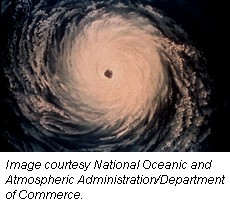It is 2012 and hurricane season is here. Tropical Depression Debby is heading out to the Atlantic after hovering over the Florida coast for four days, flooding the peninsula with a seemingly endless barrage of rain. According to the National Weather Service, the flooding remains a threat. If you are located in or around these flood-prone areas, Are you ready?
Have you put together your Hurricane Preparedness Kit? For those who haven't, now is the time to prepare. Get the official FEMA checklist of Recommended Items to Include in a Basic Emergency Supply Kit or purchase one of the ready-made Survival /Emergency Kits from Buy Two Way Radios.
Of course, basic necessities such as food and water are critical to have available and are top items on any emergency list. However, there are a other items on FEMA's list that are also extremely important. The third and fourth items listed in order of importance are a Battery-powered or hand crank radio and a NOAA Weather Radio with tone alert. The next item? Extra batteries for both radios.
Below is a list of radios that meet the federal requirements suggested in FEMA's list:
Two Way Radios
Midland GXT1000VP4 Radios With Headsets and Charger - A powerful 5 watt all-weather radio. Durable and water resistant, the GXT1000 VP4 features NOAA weather channels, NOAA weather alerts and a 3 year manufacturer warranty. This is our most popular GMRS radio.
Motorola TALKABOUT MS350R Two Way Radios - Built for performance and designed specifically for extreme weather conditions, this radio is ready. The MS350R has 11 weather channels, operates on either rechargeable or disposable batteries, is submersible and floats. It even includes a built-in flashlight! This pack also includes an Emergency Preparedness Checklist Sheet.
Motorola TALKABOUT T9680R-SAME Two Way Radios - One of the most powerful FRS/GMRS two way radios from Motorola, the T9680R is designed as a Hazard Alert radio with Specific Area Message Encoding (SAME) technology, a system adopted by the National Weather Service to warn citizens of emergency situations within their immediate area. SAME monitors the NOAA weather stations in your region for emergency situations and hazardous conditions. The T9680R can operate on either alkaline or rechargeable batteries.
Midland XT511 Base Camp Two Way/Emergency Crank Radio - This powerful device is the "swiss army knife" of two way and emergency radios.It's an FRS/GMRS radio, AM/FM clock radio with an alarm, and NOAA weather radio with weather alerts. It's also a flashlight. The Midland XT511 has five power options: AC wall power, DC vehicle adapter, rechargeable battery pack, alkaline batteries and a Dynamo hand crank. The XT511 even has a built-in USB connector to charge a USB device such as a cell phone in the event of a power outage!
NOAA Weather Radios (receive only)
Midland ER102 Emergency Crank Radio - The ER102 has the key features of the XT511 without the built-in GMRS two-way radio, but with a temperature indicator and freeze warning alert.
Midland WR-120 Weather Radio - An All Hazards Alert weather radio that monitors the Public Alert system and features SAME technology to alert you to weather or civil emergencies in your area. It also includes an alarm clock with snooze and a blue backlit display. A battery backup, color coded alert light and external antenna jack round out the features.
Midland WR-300 Weather Radio - The WR-300 has all the features of the WR-120 - with an AM/FM radio and alarm clock with snooze to boot.
Midland HH54VP2 SAME Handheld Weather Radio - This compact, portable handheld radio is a great travel companion. It has NWS all hazard alerts with S.A.M.E. technology and other emergency alerts such as Amber Alerts, biological hazard warnings, civil emergency messages, nuclear power plant warnings, fire warnings and landslide warnings. But that's not all. The HH54VP2 also features a bulit-in alarm clock with snooze, user selectable alerts, color coded alert indicators, a large, backlit display with continuous backlighting option and battery backup.
Midland HH-50 Pocket Weather Alert Radio - The Midland HH-50 is a weather radio that is so compact it fits in your pocket. It instantly auto scans for emergency and weather alerts as soon as you turn it on. The HH-50 supports all hazard alerts, emergency alerts, messages and warnings. This is a great choice for the travel size emergency kit in the car.
There is no doubt communication is critical in any emergency, but when severe weather strikes, you need to be kept up to date on current, constantly changing weather conditions in your area. During such emergencies, power can go out, landlines can be lost and cell service can lose signals. In such situations, a radio may be your only means of communication and important weather alerts.
Don't wait for the next storm to hit before you prepare. Whether you buy it or make it yourself, get your Hurricane Preparedness Kit ready now.
For more information on emergency weather radios, listen to The Two Way Radio Show Episode 13 - Emergency and Weather Radios.





 Today is June 1, 2011. While today may seem to be of little significance to the average person, the first day of June is an important marker for folks along the Gulf coast and across the eastern seaboard of the United States. Today marks the official start of the 2011 hurricane season.
Today is June 1, 2011. While today may seem to be of little significance to the average person, the first day of June is an important marker for folks along the Gulf coast and across the eastern seaboard of the United States. Today marks the official start of the 2011 hurricane season.
